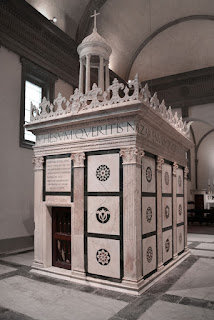The Rucellai Sepulchre in Florence, the precursor of Renaissance mausoleums.
Florence is the home of perhaps the most refined architecture in Europe. Before Bramante’s Temple at San Pietro in Montorio in Rome, there was one previous funerary monument to define the Renaissance style and it was the Tempietto di San Sepolcro in the (now former) church of San Pancrazio. The rather small, but architecturally perfect temple is the tomb of Giovanni di Paolo Rucellai, whose family still thrives in Florence today and the architect is Leon Battista Alberti.
Giovanni di Paolo Rucellai was a wealthy Florentine merchant, linked to the great architect Leon Battista Alberti through a friendship and similar tastes, and to whom Giovanni had already commissioned the construction of his Palazzo, the completion of the façade of Santa Maria Novella, and the Loggia Rucellai.
The little temple was supposed to eventually become Giovanni’s tomb, in fact it was located in the church nearest to the family Palazzo. The Tempietto is thought to have been built between 1457 and 1467, Giovanni died in 1481.
It is a scale reproduction of the Holy Sepulchre in Jerusalem, except obviously for the exterior decoration which is an interpretation on earlier Florentine Medieval and Classical styles, especially the Florentine Romanesque tradition, the main examples being San Giovanni’s Baptistry, San Miniato or the Badia Fiesolana. Alberti modernised and revalued these themes. The square-shaped mausoleum’s walls sections are divided by Corinthian pilasters and decorated with marble panels, in the centre of the different panels of green and white marbles, divided into geometrical shapes, are roundels with imaginary shapes, except the central ones which feature the Rucellai family’s most notable members and friends, coat of arms: loose sails, Giovanni de’Medici, the three-feathered chaperon, Cosimo, the diamond ring with two feathers, Piero de’Medici and the three intertwined rings, Lorenzo de’Medici. On the entablature is an inscription in a Classical font that reads a quote from the Gospel of Saint Mark, the size of the letters is the same of the inscription in the Mausoleum of Cecilia Metella in Rome, which inspired the structure. The upper part is decorated with fleur-de-lys shaped merlons, the theme is in honour of the Blessed Virgin Mary of the Annunciation to whom the Chapel was originally dedicated. The structure has a sort of apse on the wall opposite the entrance. Inside the mausoleum there are two frescoes by Giovanni da Piamonte, a follower of Piero della Francesca, the iconography is quite powerful: the dead Christ being held by two angels, and the Resurrection.
This is quite a spectacular work: the precursor of all perfect Renaissance structures and a glorious gate from death to heaven, a mystical way in which to leave the grief behind and have an anticipation of the glorious Resurrection.




